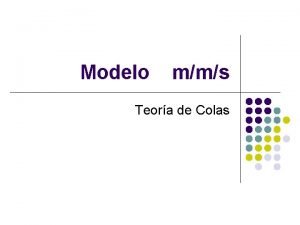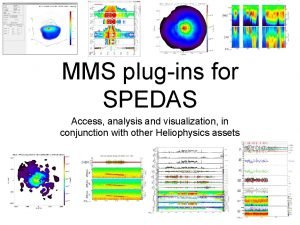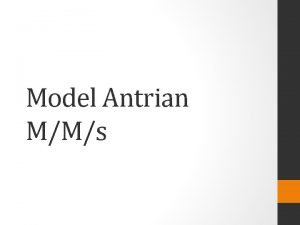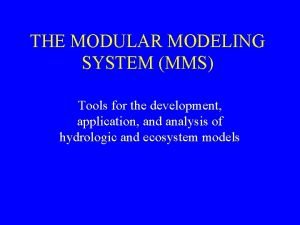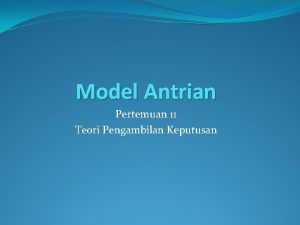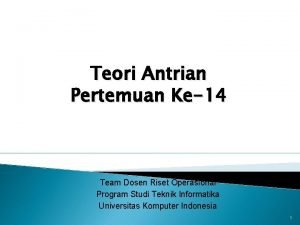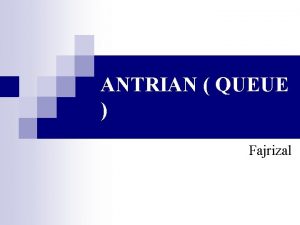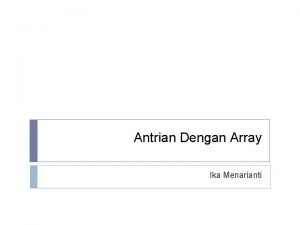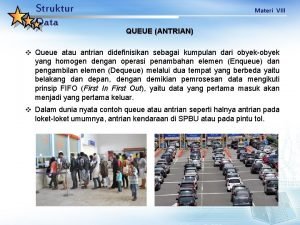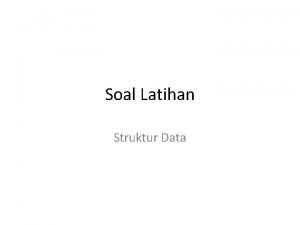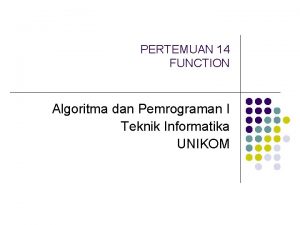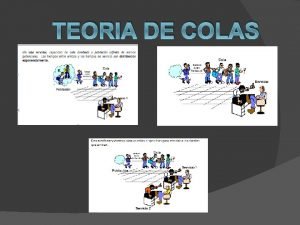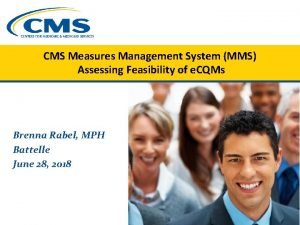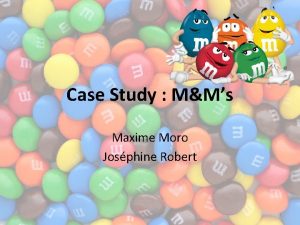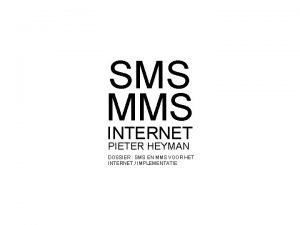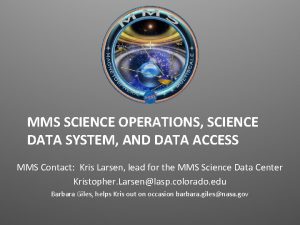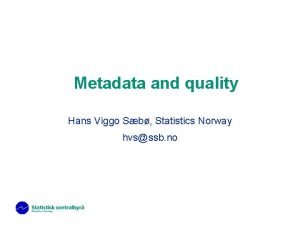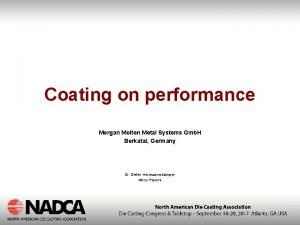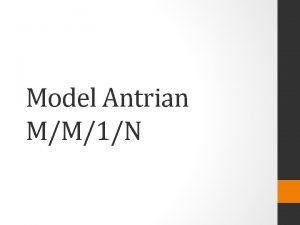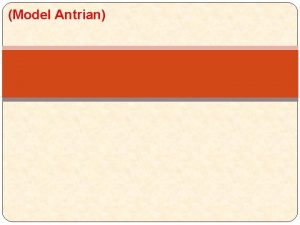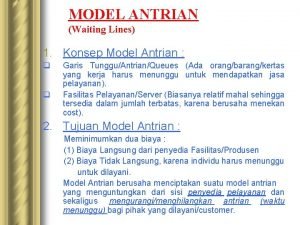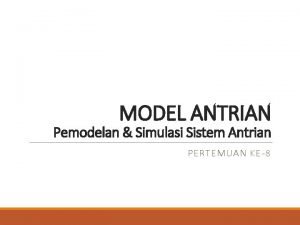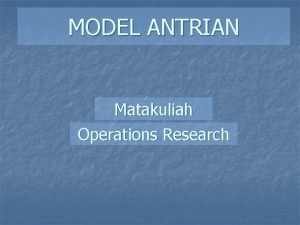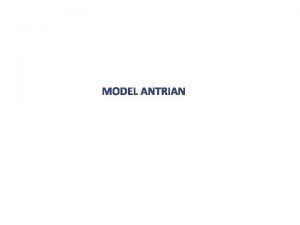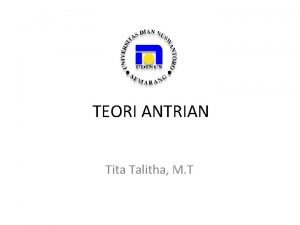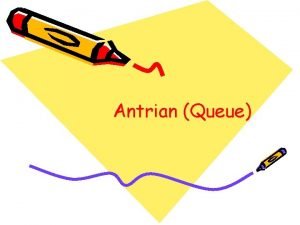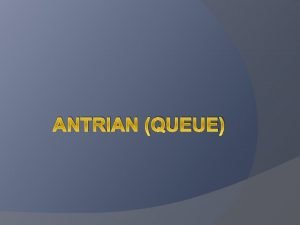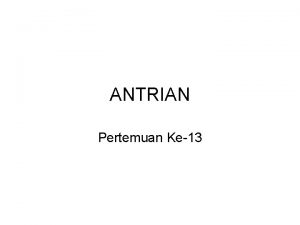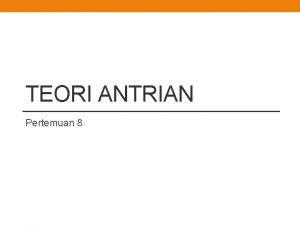Model Antrian MMs MMs R Rumani M rrmittelkom
























- Slides: 24

Model Antrian M/M/s

M/M/s

R. Rumani M / rrm@ittelkom. ac. id Telkom Institute of Technology 22 February 2021 M/M/s (s > 1) 3

Rate In = Rate Out m. P 1 = l. P 0 2 m. P 2 + l. P 0 = (l + m) P 1 3 m. P 3 + l. P 1 = (l + 2 m) P 2. . . . . sm. Ps + l. Ps-2 = {l + (s-1)m} Ps-1 (s+1)m. Ps+1 + l. Ps-1 = (l + sm) Ps (s+2)m. Ps+2 + l. Ps = (l + (s+1)m) Ps+1. . . . . R. Rumani M / rrm@ittelkom. ac. id Telkom Institute of Technology State 0 1 2. . s-1 s s+1. . 22 February 2021 M/M/s (cont. ) 4

Ps+1 = (1/s) × (l / m) Ps = R. Rumani M / rrm@ittelkom. ac. id Telkom Institute of Technology l. Now, solve for P 1 , P 2, P 3. . . in terms of P 0 P 1 = (l / m) P 0 P 2 = (l / 2 m) P 1 = (1/2!) × (l / m)2 P 0 P 3 = (l / 3 m) P 2 = (1/3!) × (l / m)3 P 0. . Ps = (1/s!) × (l / m)s P 0 22 February 2021 M/M/s (cont. ) 5

R. Rumani M / rrm@ittelkom. ac. id Telkom Institute of Technology 22 February 2021 M/M/s (cont. ) 6

then (l / m)n Cn = ----- , for n = 1, 2, . . , s. n! and , for n = s+1, s+2, . . . R. Rumani M / rrm@ittelkom. ac. id Telkom Institute of Technology Therefore, if we denote Pn = Cn× P 0 , 22 February 2021 M/M/s (cont. ) 7

if 0 £ n £ s if s £ n R. Rumani M / rrm@ittelkom. ac. id Telkom Institute of Technology 22 February 2021 M/M/s (cont. ) So, if l < sm => 8

(l / m)s = S j ----- rj P 0 j=0 s! ¥ (l / m)s = P 0 ------s! d r S ------ rj j=0 dr ¥ R. Rumani M / rrm@ittelkom. ac. id Telkom Institute of Technology Now solve for Lq: Note, r = l / sm Lq = S¥n=s (n - s) Pn = S¥j=0 j Ps+j ; Note, n = s + j 22 February 2021 M/M/s (cont. ) 9

(l / m)s = P 0 ------s! d 1 r --------dr (1 - r) (l / m)s r = P 0 ------2 s! (1 - r) R. Rumani M / rrm@ittelkom. ac. id Telkom Institute of Technology (l / m)s d ¥ Lq = P 0 ------ r ------ S rj s! dr j=0 22 February 2021 M/M/s (cont. ) 10

Wq = Lq / l (Wq: avg waiting time in Q) W = Wq + 1 / m (W: avg waiting time in sys. ) L = l (Wq + 1/m) (L: avg # in the system) = Lq + l / m R. Rumani M / rrm@ittelkom. ac. id Telkom Institute of Technology (l / m)s r Lq = P 0 ------ , r = l / sm s! (1 - r)2 (Lq : avg # in queue) 22 February 2021 M/M/s (cont. ) 11

= l / sm P(L(¥) ³ s) = {(l/m)s P 0} / {s!(1 - l/sm)} = {(sr)s P 0} / {s! (1 - r)} R. Rumani M / rrm@ittelkom. ac. id Telkom Institute of Technology r 22 February 2021 Steady-State Parameters of M/M/s Queue 12

R. Rumani M / rrm@ittelkom. ac. id Telkom Institute of Technology = sr + {(sr)s+1 P 0} / {s (s!) (1 - r)2} = sr + {r P (L(¥) ³ s) } / {1 - r} W =L/l Wq = W - 1/m Lq = l W q = {(sr)s+1 P 0} / {s (s!) (1 - r)2} = {r P (L(¥) ³ s) } / {1 - r} L - Lq = l / m = sr L 22 February 2021 Steady-State Parameters of M/M/s Queue (cont. ) 13

1. Interarrival times have an exponential distribution with a mean of 1/l. 2. Service times have an exponential distribution with a mean of 1/m. 3. Any number of servers (denoted by s). • With multiple servers, the formula for the utilization factor becomes r = l / sm but still represents that average fraction of time that individual servers are busy. © The Mc. Graw-Hill Companies, Inc. , 2003 • Assumptions 14. 14 The M/M/s Model

Comparison of Multi-Server Systems Measure M/M/11 M/M/12 M/M/13 Lq 6. 821 2. 247 0. 951 Wq 0. 682 0. 225 0. 0. 95 E 0. 909 0. 833 0. 767 Pr{ Tq = 0 } 0. 318 0. 551 0. 715 Pr{ Tq > 1 } 0. 251 0. 061 0. 014

© The Mc. Graw-Hill Companies, Inc. , 2003 14. 16 Values of L for the M/M/s Model for Various Values of s

R. Rumani M / rrm@ittelkom. ac. id Telkom Institute of Technology 22 February 2021 M/M/s Example I 22

Lq = 0. 429 (@ 43% of time, system is empty) as compared to s = 1: P 0 = 0. 20 (l / m)s r = P 0 ------2 s! (1 - r) = 0. 429 × {0. 82 ´ 0. 4} / { 2! ´ (1 - 0. 4)2 } = 0. 152 R. Rumani M / rrm@ittelkom. ac. id Telkom Institute of Technology 22 February 2021 M/M/s Example I (cont. ) 23

R. Rumani M / rrm@ittelkom. ac. id Telkom Institute of Technology Wq = Lq / l = 0. 152 / (1/10) = 1. 52 (min) W = Wq + 1 / m = 1. 52 + 1 / (1/8) = 9. 52 (min) What proportion of time is both repairman busy? (long run) P(N ³ 2) = 1 - P 0 - P 1 = 1 - 0. 429 - 0. 343 = 0. 228 22 February 2021 M/M/s Example I (cont. ) 24

R. Rumani M / rrm@ittelkom. ac. id Telkom Institute of Technology Many early examples of queuing theory applied to practical problems concerning tools for service. Attendants manage the tools, while mechanics, assumed to be from an infinite calling population, arrive for service. Assume Poisson arrivals at rate 2 mechanics per minute and exponentially distributed service times for attendance with mean 40 seconds. How many attendants are required for statistical equilibrum (Steady state)? 22 February 2021 M/M/s Example 2 25

Thus, at least s = 2 attendants are needed. The quantity 4/3 is the expected number of busy server, and for s ³ 2, r = 4 / (3 s) is the long-run proportion of time each server is busy. (What would happen if there were only s = 1 server? ) s=2 R. Rumani M / rrm@ittelkom. ac. id Telkom Institute of Technology l = 2 per minute, and m = 60/40 = 3/2 per minute. Since, the offered load is greater than 1, that is, since, l / m = 2 / (3/2) = 4/3 > 1, more than one server is needed if the system is to have a statistical equilibrium. The requirement for steady state is that s > l / m = 4/3. 22 February 2021 M/M/s Example 2 (cont. ) 26

M/M/s Example 2 (cont. ) = {1 + 4/3 + (16/9)(1/2)(3)} -1 = {15 / 3}-1 = 1/5 = 0. 2 The probability that all servers are busy is given by P(L(¥) ³ 2) = {(4/3)2 (1/5)} / {2!(1 - 2/3)} = (8/3) (1/5) = 0. 533 R. Rumani M / rrm@ittelkom. ac. id Telkom Institute of Technology 22 February 2021 Let there be s = 2 attendants. First, P 0 is calculated as 27

and the time-average number in system is given by L = Lq+ l/m = 16/15 + 4/3 = 12/5 = 2. 4 mechanics Using Little’s relationships, the average time a mechanic spends at the tool crib is W = L / l = 2. 4 / 2 = 1. 2 minutes while the avg time spent waiting for an attendant is Wq = W - 1/m = 1. 2 - 2/3 = 0. 533 minute R. Rumani M / rrm@ittelkom. ac. id Telkom Institute of Technology Thus, the time-average length of the waiting line of mechanics is Lq = {(2/3)(8/15)} / (1 - 2/3) = 1. 07 mechanics 22 February 2021 M/M/s Example 2 (cont. ) 28

© The Mc. Graw-Hill Companies, Inc. , 2003 A grocery store has three registers open. Customers arrive to check out at an average of 1 per minute (Poisson). The service time averages 2 minutes (exponential). Please calculate these parameters : (Po, L, Lq, W, Wq) 14. 29 Example 3 QUIZ until 10: 00
 M/m/s formulas
M/m/s formulas Spedas
Spedas Mmsmms
Mmsmms Mms model
Mms model Contoh soal teori antrian dan jawabannya
Contoh soal teori antrian dan jawabannya Contoh soal antrian riset operasi
Contoh soal antrian riset operasi Jenis struktur data kue sering digunakan untuk
Jenis struktur data kue sering digunakan untuk Antrian
Antrian Contoh satu saluran banyak tahap
Contoh satu saluran banyak tahap Teori antrian riset operasi
Teori antrian riset operasi Macam macam aturan antrian
Macam macam aturan antrian Materi queue struktur data
Materi queue struktur data Contoh kasus stack
Contoh kasus stack Diketahui suatu array segitiga memiliki 5 baris dan kolom
Diketahui suatu array segitiga memiliki 5 baris dan kolom Algoritma antrian
Algoritma antrian Teoria de colas formulas
Teoria de colas formulas Mms blueprint
Mms blueprint Mms case study
Mms case study Mtps.mms
Mtps.mms Sms wordt mms
Sms wordt mms Mms sdc
Mms sdc Viggo mms
Viggo mms Www.scsb.org mms
Www.scsb.org mms Stabil crucible
Stabil crucible Open bee download
Open bee download
